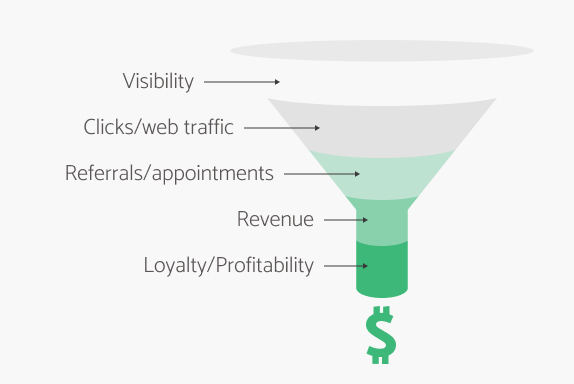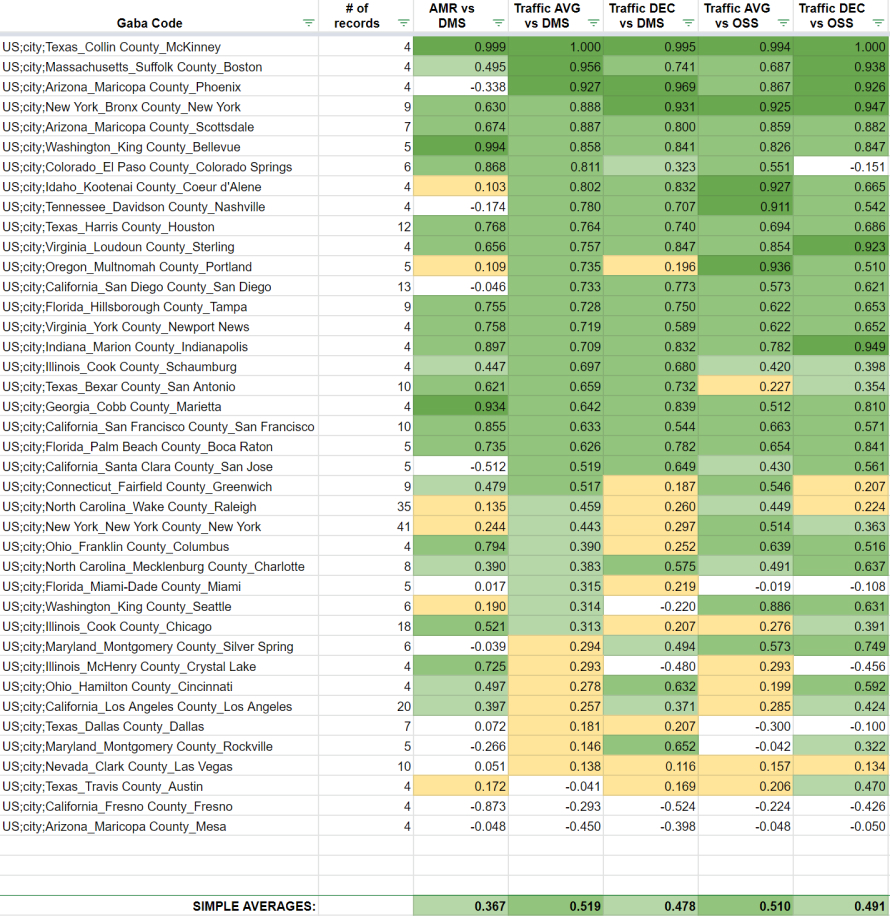For over twenty years, businesses have been making substantial investments in digital marketing and related technologies. While advances in marketing technology have been a consistent driver of business growth, truly understanding the impact of marketing tactics on local consumer awareness has been elusive.
While this challenge impacts businesses of all sizes, the pain is felt most acutely by businesses who provide consumer services at a local level. One such type of business is dental practices. In highly competitive markets, dentists are often left to pour marketing dollars into programs with significant blind-spots in competitive insight, and the relationship between typical marketing strategies and patient acquisition goals.
This joint analysis with an industry leading patient acquisition and engagement platform connects the dots between online marketing visibility and business success in customer acquisition and engagement.
Key findings

of the local markets analyzed showed a correlation between DMscore and
average web traffic

of the local markets analyzed showed a correlation between DMscore and
successful appointment bookings

Increasing a DMscore from 10 to 25
doubles the amount of web traffic on average
Increasing a DMscore from 25 to 50
also results another doubling of web trafficA brief history of digital marketing technologies
To understand the digital marketing challenges facing local consumer facing businesses, it is useful to understand the evolution of digital marketing tactics and tools.
In the early 90’s, a wave of businesses engaged in the modern equivalent of the gold rush of 150 years earlier. The promise of a rapidly growing audience for their ideas, products and services was a palpable motivator for new born-on-the-web companies, as well as for traditional brick and mortar operations.
The early days of an online business left a lot to be desired. The early web pages of the day were no more than clumsy brochures without any call to action or hint of commerce activity.
Of course this evolved quickly as the audience grew and three main ways to make money online started to sprout. By 1994, online advertising, lead-generation, and e-commerce began to emerge. For the second half of the nineties the internet population roughly doubled each year, leading to a thriving online advertising business, and a dramatic increase in the amount of information available.
It was during this frenzy, three new technologies changed the landscape. The first was the rise of directories such as Yahoo, followed by search engines like Lycos and AltaVista. The second was ad serving companies like DoubleClick. Then came the first generation of web analytics offerings from companies such as WebTrends.
The 2000’s
So by the dawn of the millennium, businesses could easily put up a website, collect leads, put up interesting content or products, monetize their efforts by selling ads or goods, and measure their website performance with early web analytics offerings.
In 2000 a new form of advertising was born. Overture.com pioneered the concept of pay-per-click advertising followed quickly and made famous by Google. This form of advertising which benefited greatly from contextual understanding of user behavior, changed the advertising model from more traditional magazine style graphics to a more targeted text ad appealing to people who are in the middle of a search.
The first decade of the 2000s saw a boom in both new users, websites, content, and advertising networks.
The second generation of web and digital analytics offerings also evolved quickly to keep up with the measurement of website traffic, lead generation, user journeys, advertising performance, and e-commerce. In the 2010s the Marketing Technology landscape of amazing products and services grew dramatically with roughly 150 Marketing Technology solutions in 2011, rising to 8000 by 2020.
Despite this mind boggling revolution in ways to market, influence, sell, retain, and analyze online consumers, one big blind spot remained. Understanding your share of attention within your local market was frustratingly opaque. Part of this was to do with the fragmentation of advertising networks, but largely this had to do with the intentional concealment by major players in order to maintain control over the advertising dynamics to maximize their revenue.
Measuring marketing visibility & big data
As the online advertising, search, and directories landscape consolidated down to a few key players, the opportunity to take advantage of the Pareto Principle arose allowing you to optimize your digital marketing efforts. This also meant it was possible to gain an understanding of your potential audience in a way that could be made not only accurate to the size, but precise to the local level. This is where DMscore comes in.
DMscore is able to piece together the key marketing visibility signals and metrics that cover the vast majority of potential customers to a business at a local level. We are able to do this through the existence of new data sources and the capabilities of so called “big data” technology. The end result is a simple score that tells a business their relative strength of consumer attention at a local level. We can also show you how you compare to competitors in the same local area. This is something that has not been possible to do with a significant amount of accuracy or scale before.
The DMscore philosophy: Make it simple, powerful and actionable
The DMscore philosophy is to reduce the complexity surrounding analytics so as to focus on the business conversation that matters most. As such, we provide a simple set of scores and recommendations, while recognizing that traditional website, conversion rate, and search engine optimization applications and services might be tapped to solve some of the more technical challenges.
Since our main focus is on visibility measurement and competitive intelligence, we felt it necessary to explore the accuracy and business decisions that might be taken as a result of this unique insight. To this end we enlisted the help of one of the largest dental platforms, serving thousands of practices today, to prove the connection between marketing visibility and commercial success.
The role of online marketing in business success
When we think about how a potential customer or patient might find a local business, it’s clear that the vast majority of consumers will begin their journey with a search engine. Either searching for a web site and content, or searching on a map and looking at a directory listing. So in this way, marketing visibility can be thought of as the top of the customer journey funnel.
The customer journey: from visibility to profitability

Once the click occurs and a prospective customer or patient arrives at the site, any number of experiences can influence the visitor to engage with the business in desirable ways. This begs the question: what is the relationship between marketing visibility and web traffic and engagement on the website?
As you might expect this journey does indeed act like a funnel. When more attention is garnered, more clicks occur, then more visitors are captured, and more customers are acquired and more products and services are sold. It’s really just that simple.
DMscore correlation for local market success
To prove this out we were able to combine our market visibility data with aggregate business performance data from 1248 dental businesses in hundreds of geographic regions. To ensure accuracy we focused on geographic regions with a minimum of 4 businesses represented. This narrowed our analysis to 330 businesses with the results shown below.

Using the Pearson correlation coefficient, a statistical method to measure how closely related two sets of data are, we calculated the correlation between a DMscore and web traffic. We found over 90% of the local areas analyzed showed a strong correlation between the two metrics.

Since we had both the web site traffic information, and the appointment information scheduled on the site, we could draw the direct correlation between DMscore and appointment settings on the dental site and practice success. Although there is more that can complicate the conversion from visit to appointment we still saw a very strong 73% correlation.
Conclusion: Digital Transformation Guaranteed
Knowing the local DMscore is critical for several reasons –
- DMscores will provide you with metrics and actionable recommendations to attract dozens or even thousands more visitors and revenue for each location – depending on the demographics of your area.
- DMscores will give you the decision support you need to optimize resources, and focus those on locations that require the most urgent attention with the lowest scores.
- DMscores will provide a common understanding and help unify decision making from CEO and CMO and their staffs, with local practice providers and your digital marketing agencies.
- Trends and alerts will help you to stay on top of each location over time as the competition changes.
About DMscore
The DMscore (Digital Marketing score) technology was created by industry visionaries, executives and investors who helped build the first Digital Analytics companies like Adobe Analytics, and FICO platforms. The DMscore Enterprise application creates marketing insights for B2B marketers across markets.
![]()

